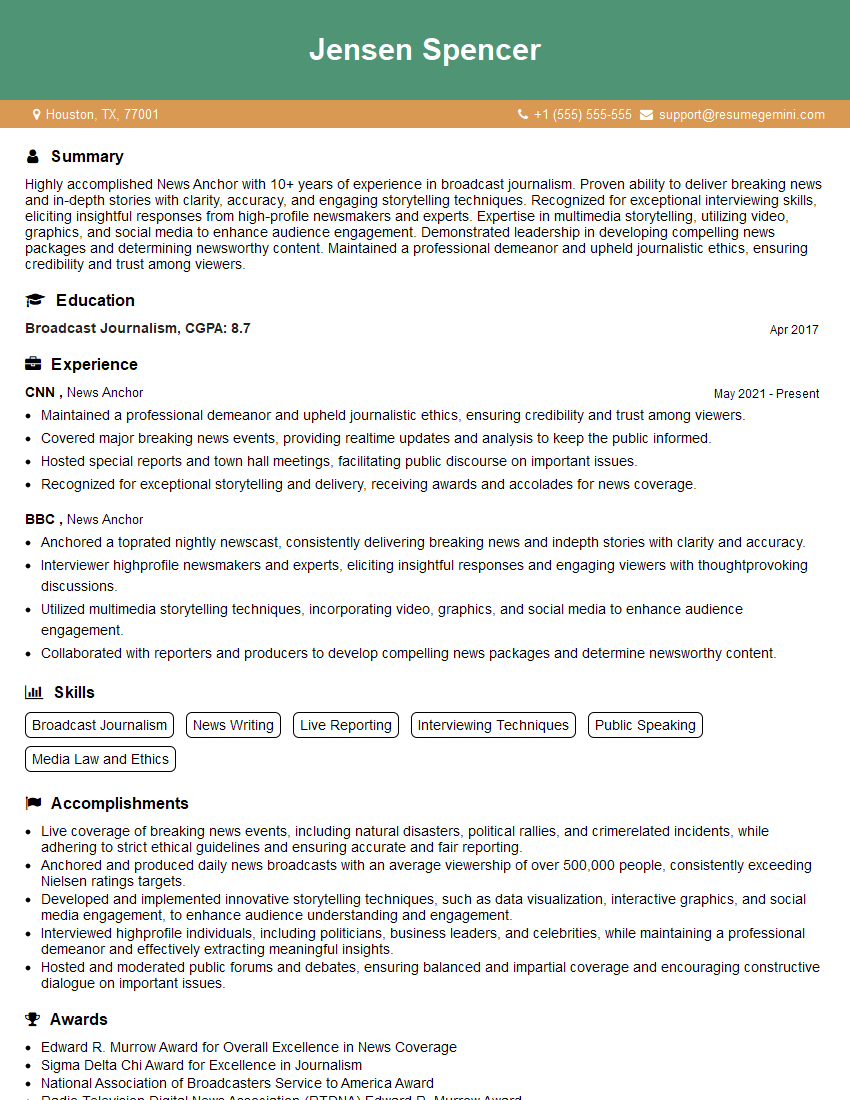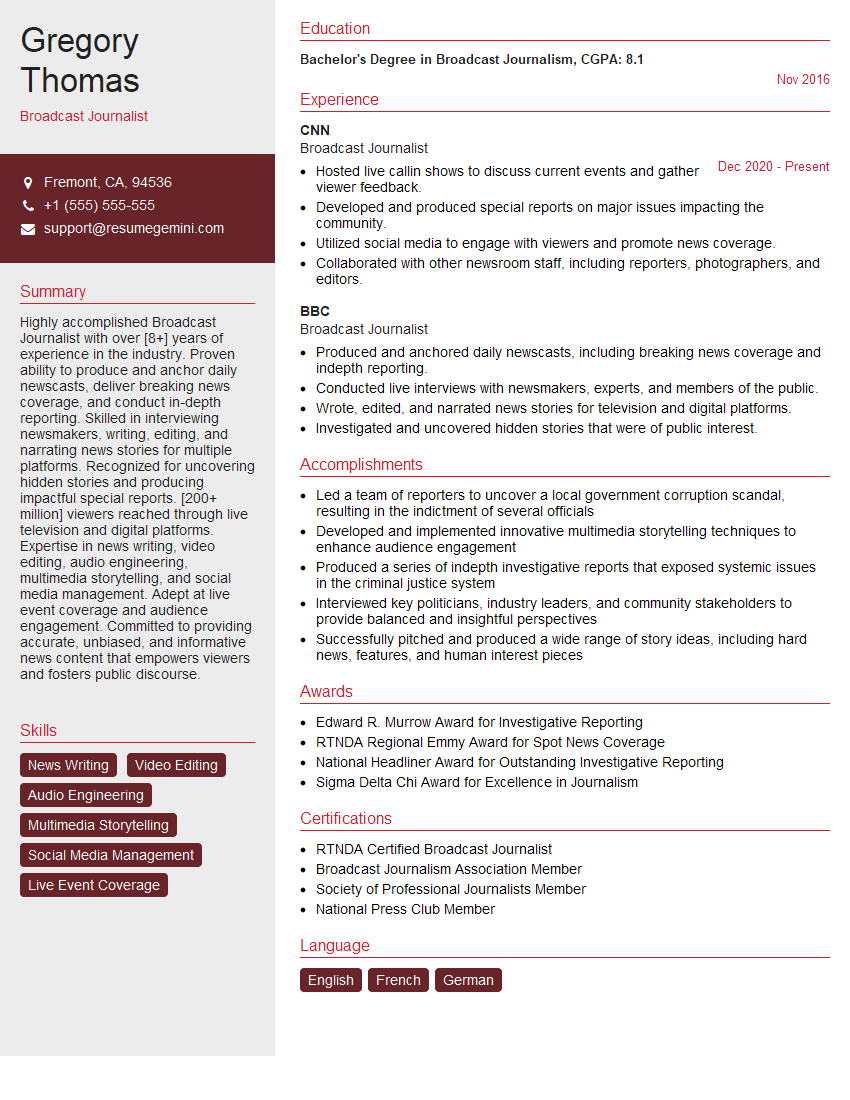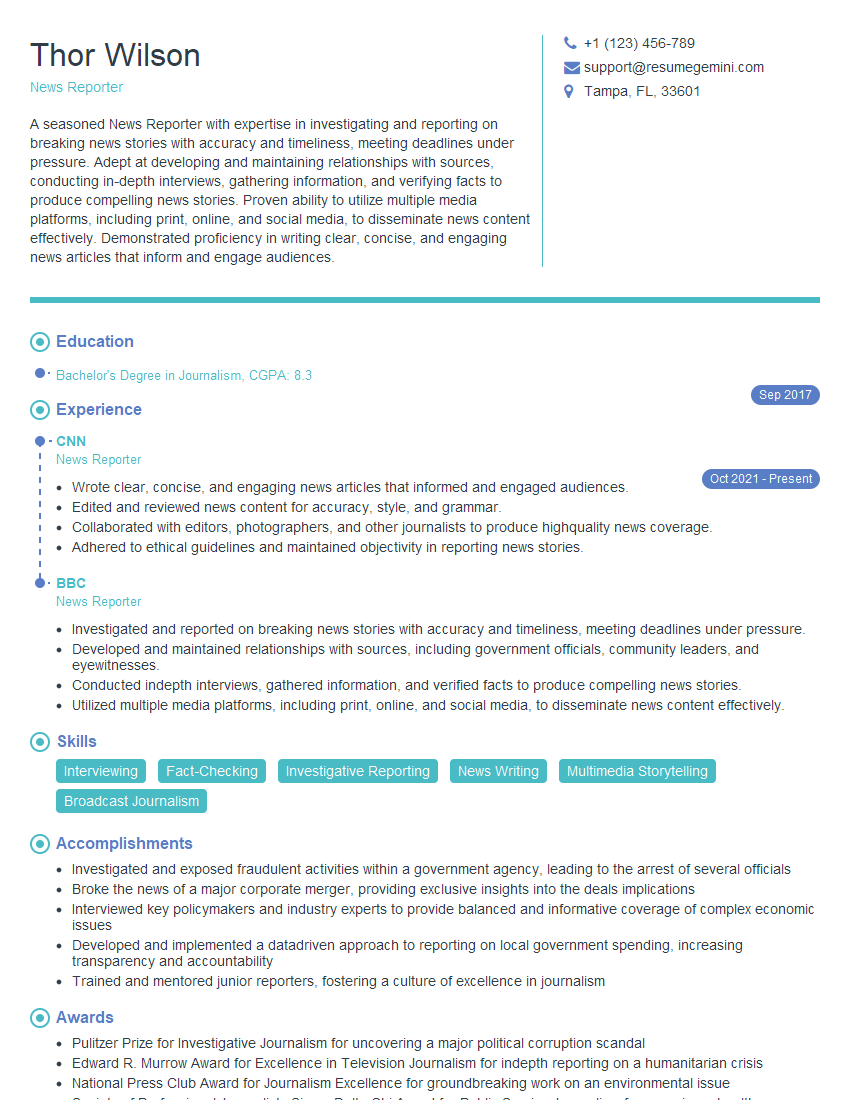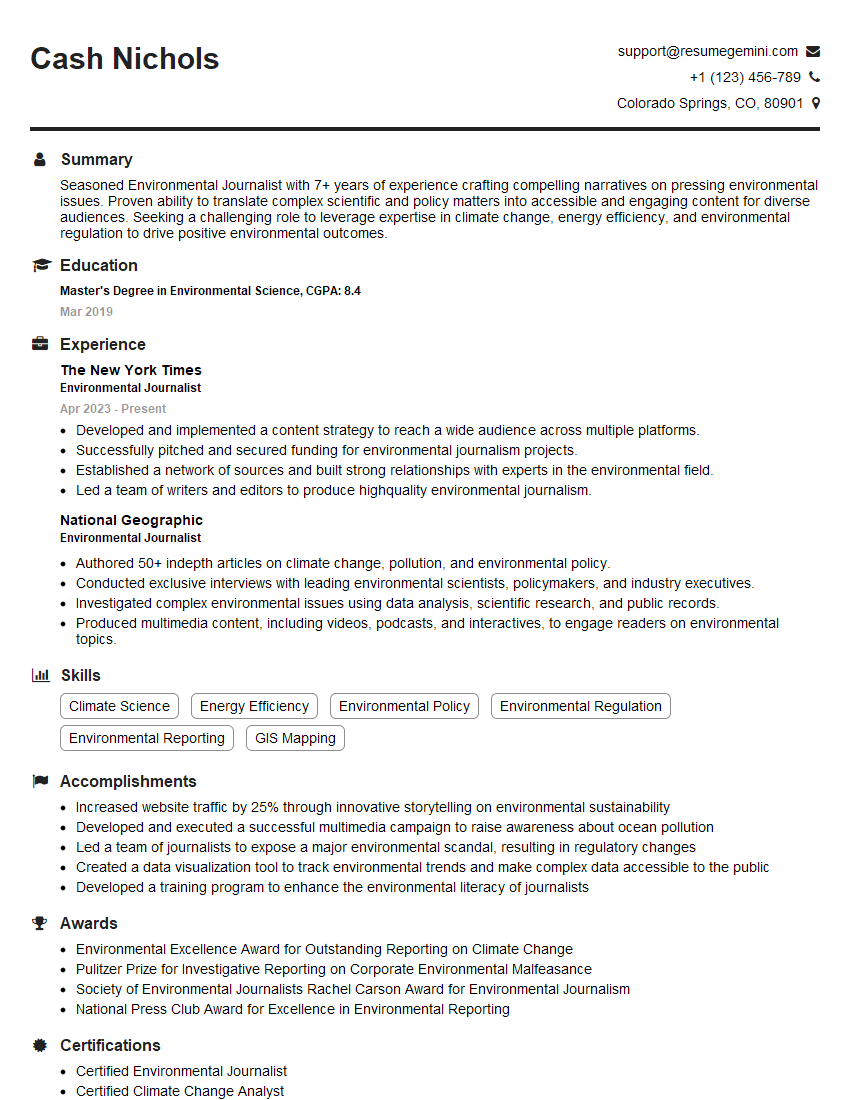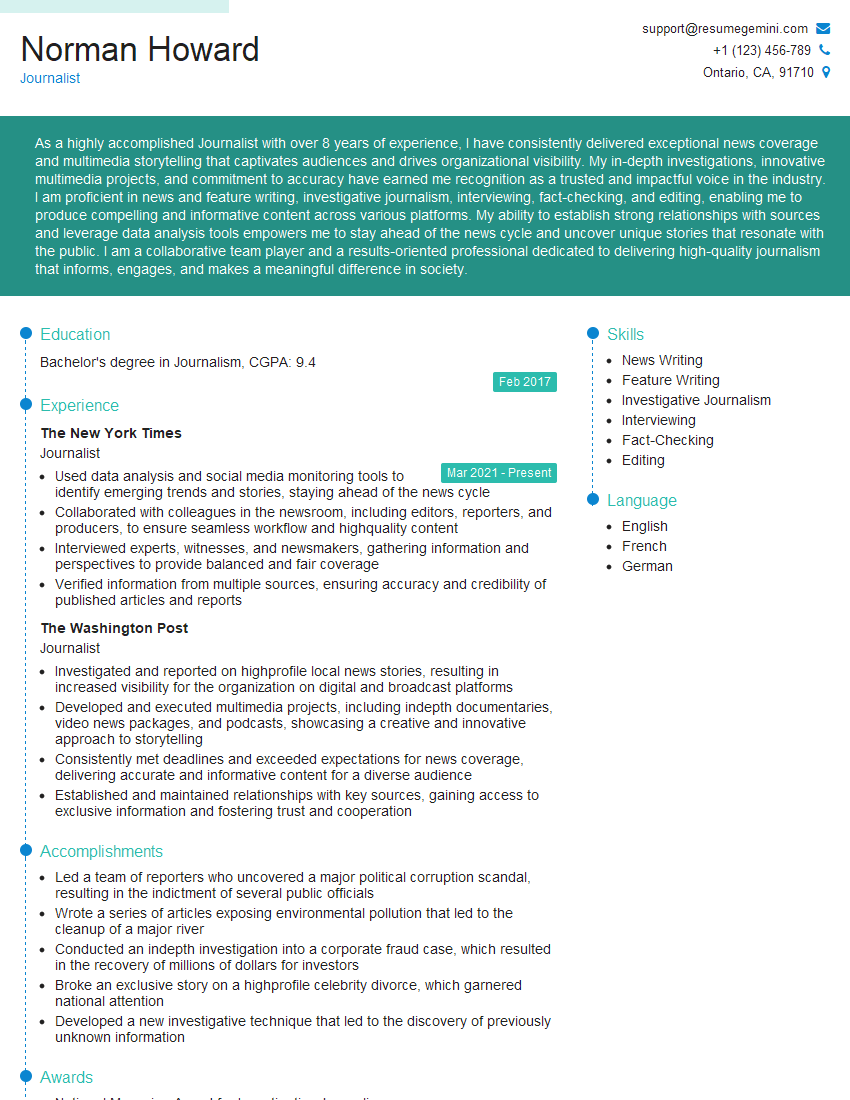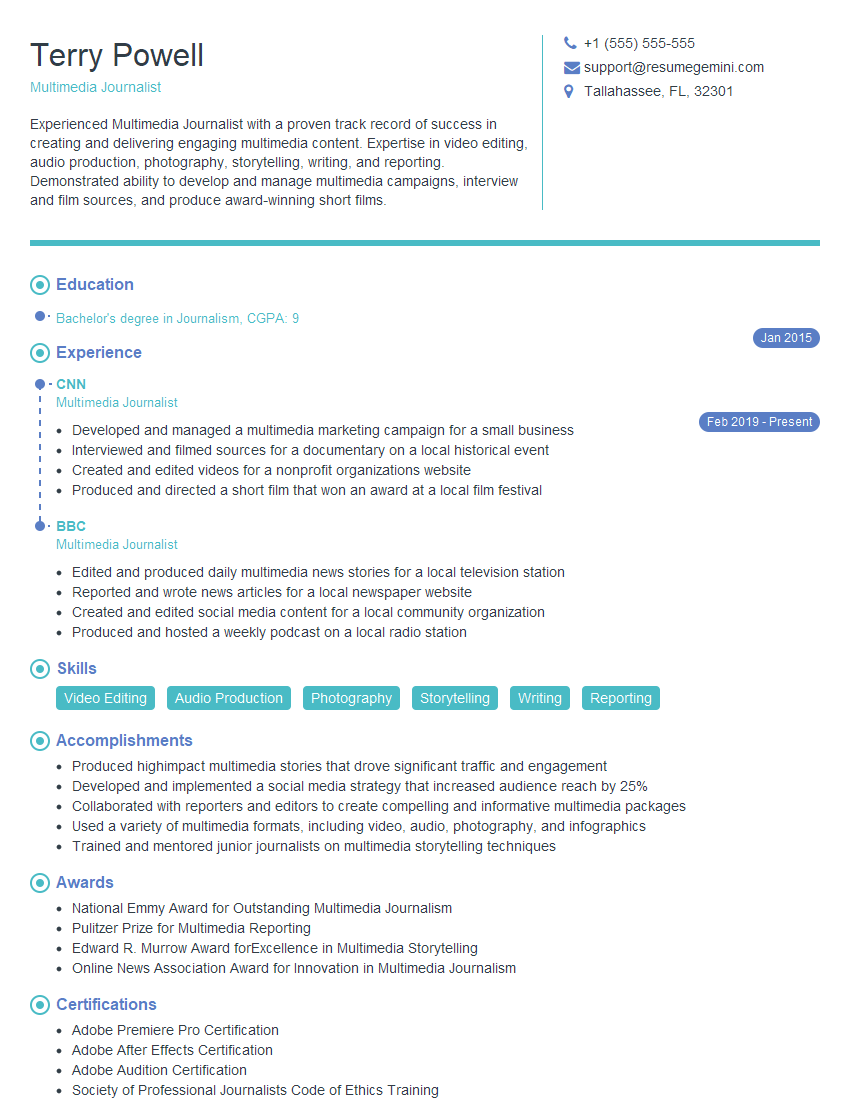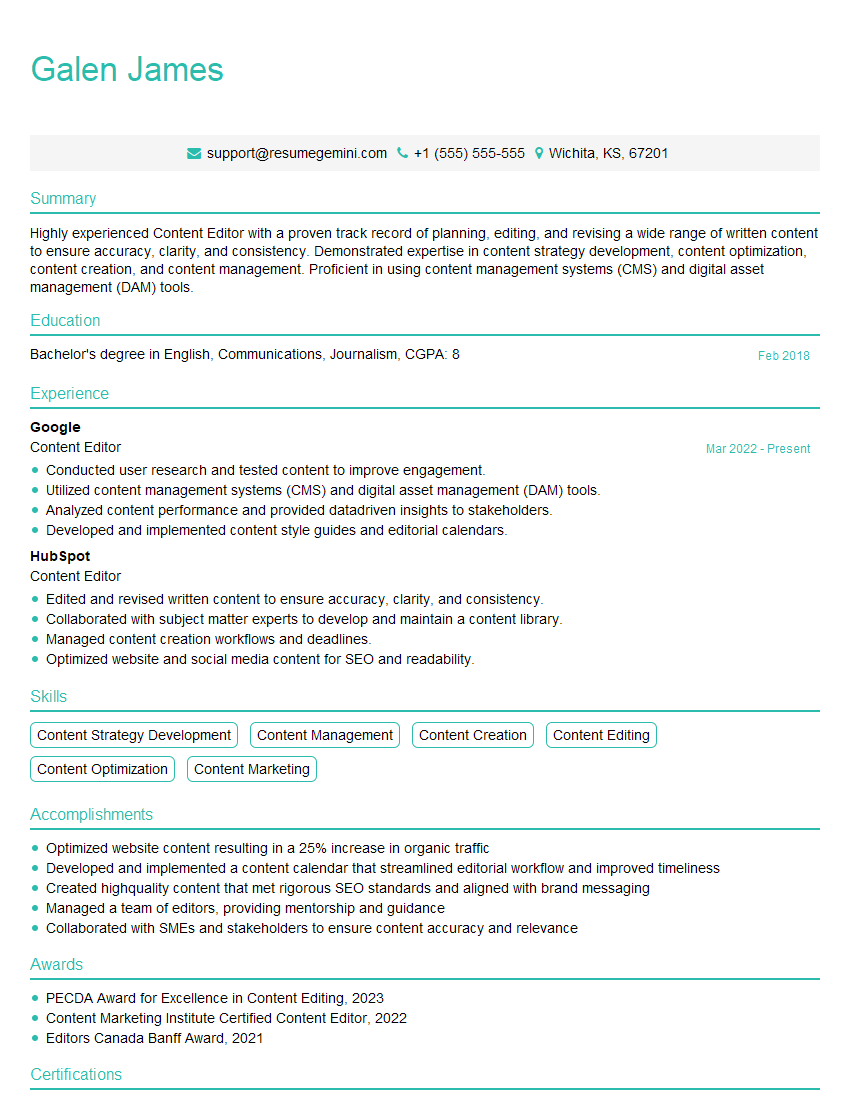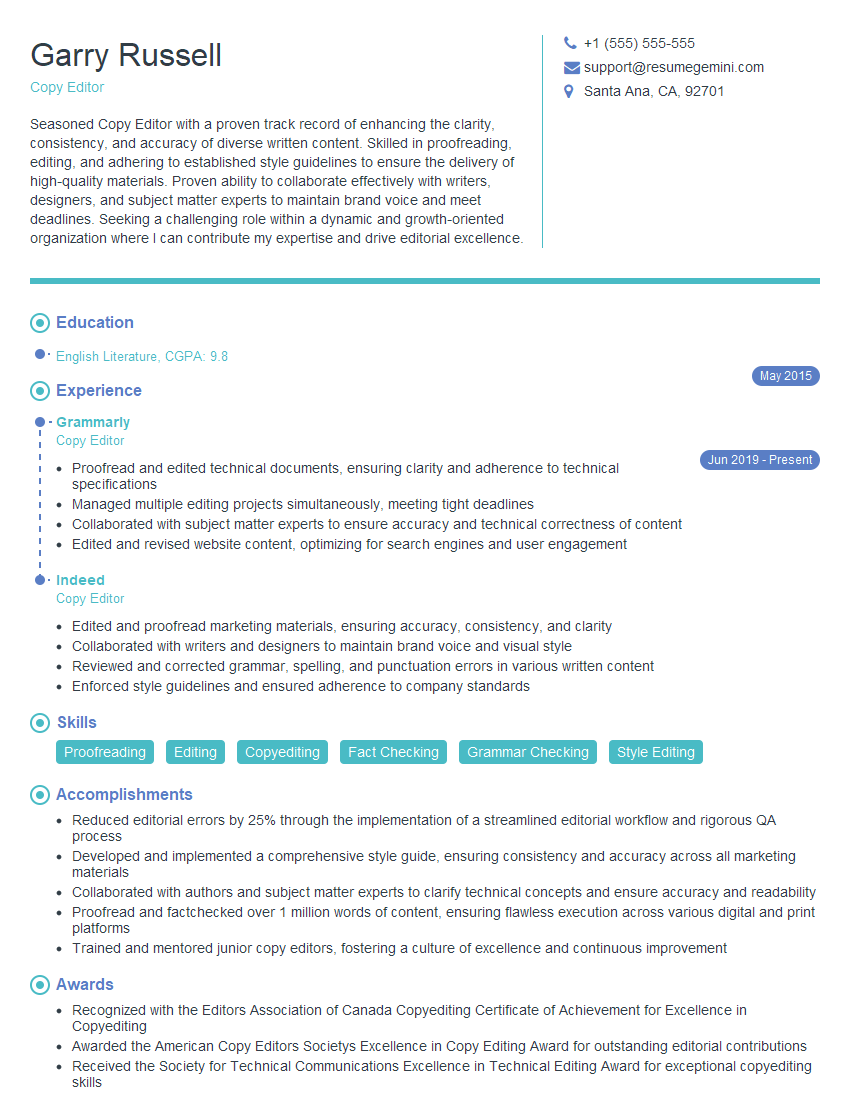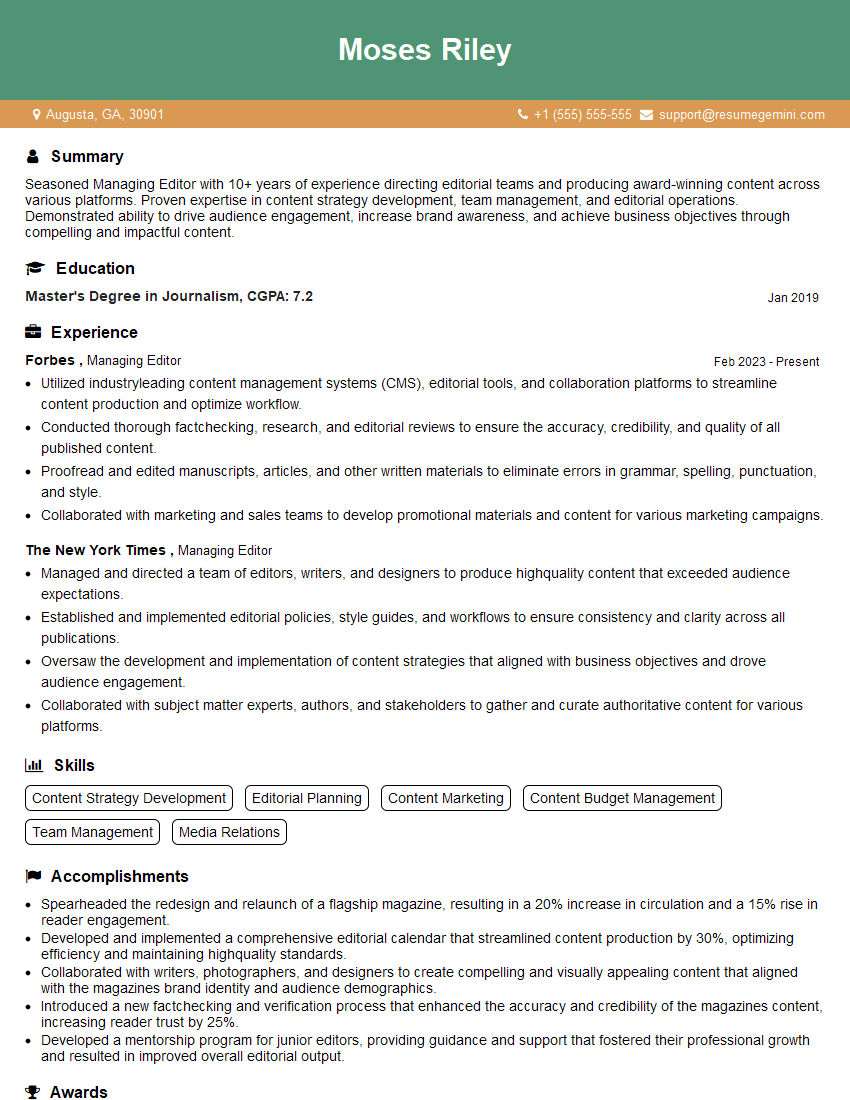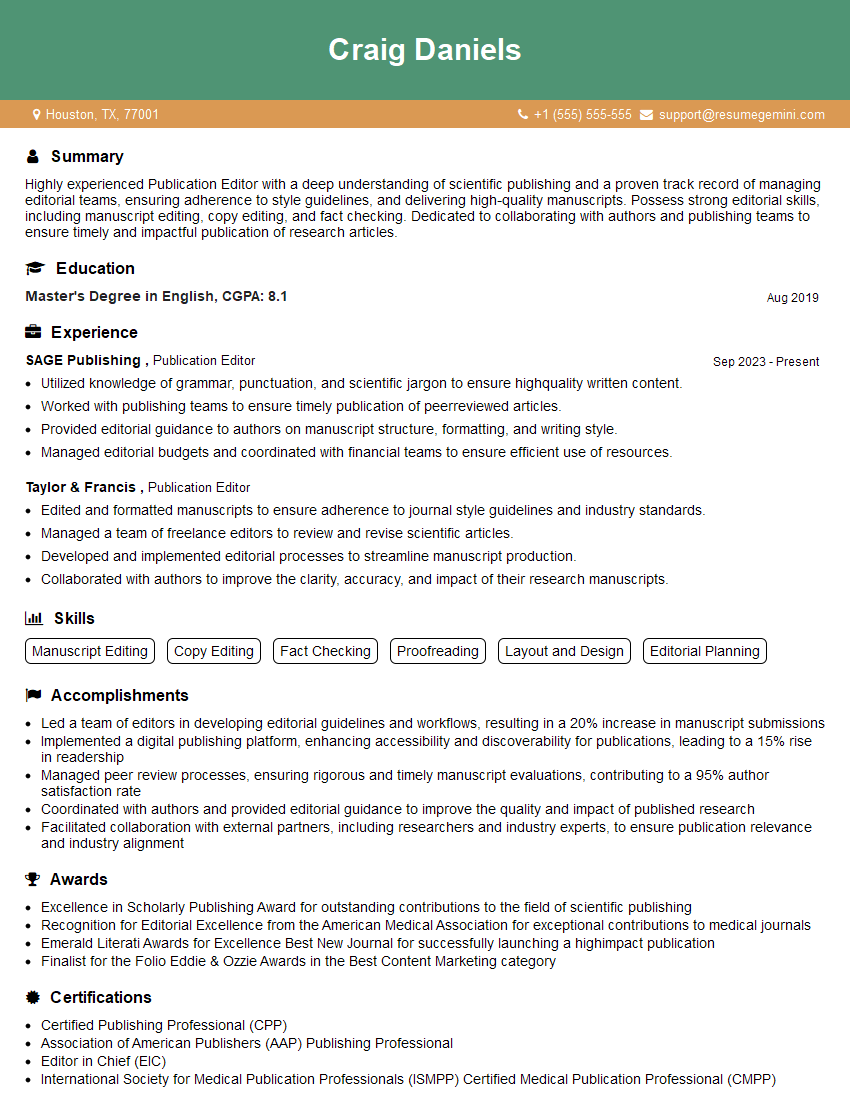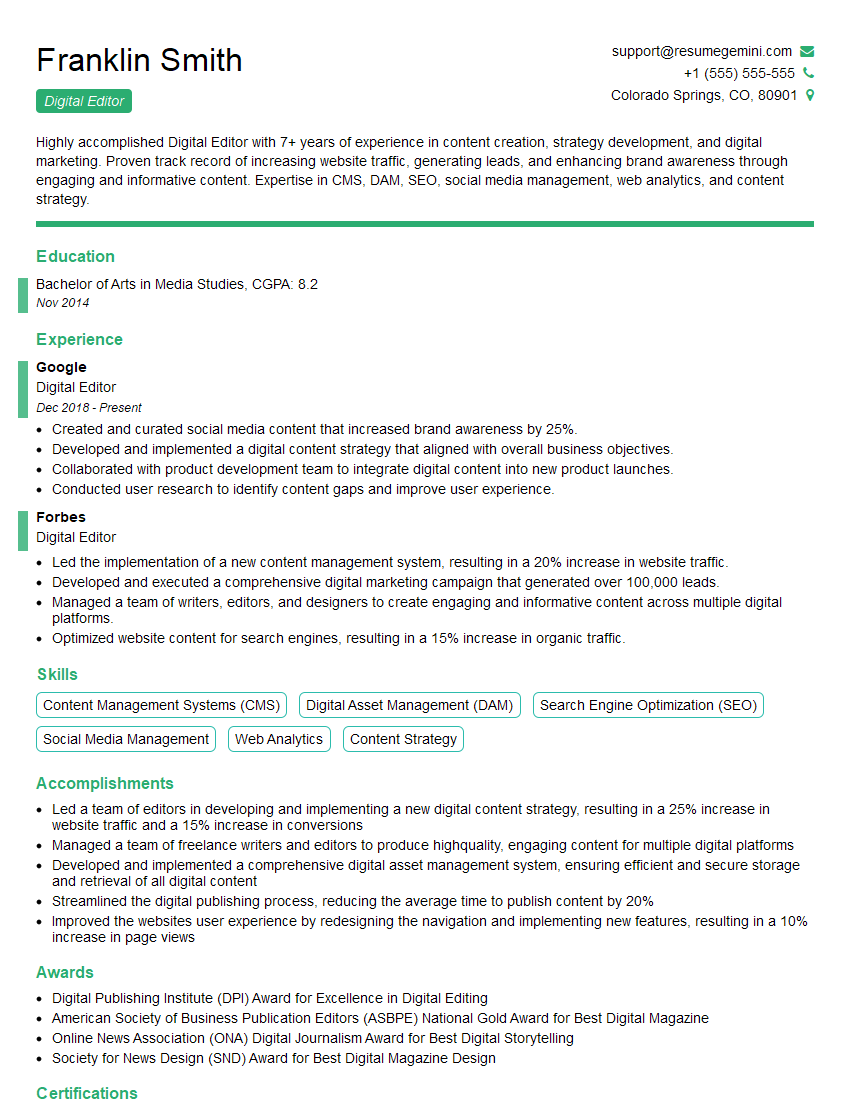Feeling uncertain about what to expect in your upcoming interview? We’ve got you covered! This blog highlights the most important Journalistic Integrity interview questions and provides actionable advice to help you stand out as the ideal candidate. Let’s pave the way for your success.
Questions Asked in Journalistic Integrity Interview
Q 1. Define ‘journalistic integrity’ in your own words.
Journalistic integrity is the unwavering commitment to truth, accuracy, fairness, and independence in the pursuit and dissemination of news. It’s the bedrock of a journalist’s credibility, ensuring the public receives information they can trust. It’s not just about avoiding outright lies, but also about diligently seeking the truth, representing all sides fairly, and acknowledging limitations in one’s reporting.
Think of it like a tightrope walk: balance is key. Accuracy is one side, fairness is the other, and journalistic integrity keeps you from falling off.
Q 2. Explain the importance of fact-checking in maintaining journalistic integrity.
Fact-checking is the cornerstone of journalistic integrity. Without it, even well-intentioned reporting can be misleading or outright false. It’s a rigorous process of verifying information from multiple reliable sources before publication. This includes checking the accuracy of facts, figures, quotes, and claims. Failure to fact-check erodes public trust and can have serious consequences, from minor corrections to significant retractions and damage to a publication’s reputation.
For instance, imagine a story claiming a specific politician made a certain statement. A responsible journalist would not only verify the statement itself but also check the context in which it was made, the date, and the source of the quote. They might cross-reference this information with recordings, transcripts, and other independent reports.
Q 3. Describe a situation where you had to make a difficult ethical decision in your journalistic work.
Early in my career, I was working on a story about alleged corruption within a local government. I had a strong anonymous source providing detailed information, but verifying the source’s identity and the information provided proved extremely challenging. Publishing the story without verification would have compromised journalistic integrity; withholding it meant potentially letting corruption go unaddressed.
I opted for a cautious approach, corroborating the information from several other independent sources before publishing. I avoided naming the anonymous source explicitly while clearly stating that the information was from a source who wished to remain anonymous. This ensured that while protecting my source, the public received accurate information supported by multiple verifications. This demonstrates the ethical challenge of balancing source protection with the public’s right to know.
Q 4. How do you handle pressure to compromise your journalistic integrity?
Pressure to compromise journalistic integrity can come from various sources: editors, advertisers, powerful individuals, or even self-imposed deadlines. My strategy involves a multi-pronged approach. First, I always prioritize accuracy and fairness. Second, I document any such pressure, keeping a clear record of communications and decisions made. Third, I seek counsel from trusted colleagues or editors who uphold ethical journalistic standards. Finally, if necessary, I am prepared to escalate concerns to higher management or even outside bodies dedicated to press freedom and ethics. A strong ethical compass is crucial, as is a clear understanding of my own professional values and the potential consequences of compromising them.
Q 5. What are the key ethical considerations when covering sensitive topics?
Covering sensitive topics, such as sexual assault, child abuse, or hate crimes, requires extra sensitivity and ethical consideration. Key considerations include:
- Minimizing harm: Avoiding language that could further traumatize victims or perpetuate harmful stereotypes.
- Respect for privacy: Protecting the identities of victims unless they explicitly consent to be identified.
- Accuracy and context: Ensuring that information is accurate and presented in a way that provides appropriate context and avoids sensationalism.
- Fairness and balance: While protecting victims, it’s also crucial to present the other side of the story fairly, if relevant, without further endangering the victim.
For example, when covering sexual assault, using euphemisms or minimizing the event should be completely avoided.
Q 6. How do you identify and avoid bias in your reporting?
Identifying and avoiding bias is an ongoing process requiring constant self-reflection and critical examination. This involves several steps:
- Self-awareness: Recognizing one’s own personal biases and perspectives.
- Source diversification: Seeking diverse sources representing a range of viewpoints.
- Balanced language: Using neutral and objective language, avoiding loaded words or phrases.
- Fact-checking rigorously: Verifying information meticulously from multiple sources to reduce the impact of any potential bias.
- Seeking feedback: Asking colleagues or editors to review one’s work for any signs of bias.
For example, when covering a political issue, ensure that you are quoting and representing both sides in a balanced manner and refraining from injecting your own personal opinion into the reporting.
Q 7. How do you verify information received from anonymous sources?
Verifying information from anonymous sources is challenging but sometimes necessary for uncovering important information. Key steps include:
- Source corroboration: Confirming information with multiple independent sources.
- Background checks: Investigating the source’s background and credibility, if possible, without revealing their identity.
- Contextual analysis: Evaluating the consistency and plausibility of the information provided.
- Transparency: Clearly stating in the story that the information is from an anonymous source and why their identity is being protected.
It’s crucial to understand that reliance on anonymous sources should be approached cautiously and only employed when information cannot be obtained through other means. The level of verification required increases significantly when relying on anonymity.
Q 8. What steps do you take to ensure accuracy in your reporting?
Accuracy is the cornerstone of journalistic integrity. It’s not just about getting the facts right, but also about presenting them in a fair and unbiased way. My approach involves a multi-layered process.
Multiple Source Verification: I never rely on a single source. I cross-reference information from at least three independent sources, comparing their accounts to identify discrepancies and ensure consistency.
Fact-Checking: I meticulously check all facts, figures, and dates using reputable fact-checking websites and databases. This includes verifying claims made by individuals, institutions, or government entities.
Contextualization: I strive to provide sufficient context to avoid misrepresentation. A fact taken out of context can be misleading. I carefully explain the background, circumstances, and implications of the information I present.
Verification of Visuals: If using images or videos, I verify their authenticity and origin to ensure they haven’t been manipulated or taken out of context.
Peer Review: Before publication, I always seek feedback from colleagues, editors, and fact-checkers to identify any potential errors or biases.
For example, when reporting on a complex scientific study, I would consult with the researchers, examine the study methodology and data, and seek expert opinions from other scientists to ensure a balanced and accurate portrayal.
Q 9. Explain the difference between opinion and fact in journalism.
The distinction between opinion and fact is crucial in journalism. Facts are verifiable statements that can be proven true or false using evidence. Opinions, on the other hand, are subjective judgments or beliefs that cannot be objectively verified.
In a news report, facts should be presented objectively, without personal bias or interpretation. Opinions, if included, should be clearly identified as such and attributed to a specific source. An opinion piece, such as a column or editorial, is a different matter, where subjective perspectives are expected and even encouraged, but even in these, facts should be used accurately to support the arguments presented.
For instance, stating “The temperature in New York City was 75°F yesterday” is a fact. Saying “New York City had a pleasant day yesterday” is an opinion, as ‘pleasant’ is subjective and depends on individual preferences. A journalist needs to make sure this line is kept clear.
Q 10. How do you balance the public’s right to know with the need to protect privacy?
Balancing the public’s right to know with the need to protect privacy is one of the most significant ethical dilemmas in journalism. There’s no easy answer, and it often requires careful consideration on a case-by-case basis.
Relevance: Information should only be published if it’s clearly relevant to a matter of public interest. A minor detail about someone’s personal life, even if true, is unlikely to justify a breach of privacy.
Harm: Journalists must consider the potential harm publication could cause to individuals. Does the public benefit from disclosing this information outweigh the potential harm to the individual?
Proportionality: The information published should be proportionate to the public interest. Avoid unnecessarily intrusive details.
Anonymity and Pseudonymity: When feasible, consider offering sources anonymity or using pseudonyms to protect their identities while still presenting valuable information. However, note this can impact credibility.
For example, in a story about corruption within a government agency, revealing the names of whistleblowers might be justified if the information provided is crucial to public accountability, but if such disclosure put the sources in danger, stronger measures of protection must be taken.
Q 11. Describe your experience using fact-checking tools and resources.
I regularly utilize a variety of fact-checking tools and resources, including:
Reputable Fact-Checking Websites: Sites like Snopes, PolitiFact, and FactCheck.org are invaluable resources for verifying claims and identifying misinformation.
Online Databases: I use databases like LexisNexis and Westlaw to access legal documents, news archives, and other official records.
Government and Institutional Websites: Official websites of government agencies and academic institutions are credible sources of information. Always verifying the source.
Reverse Image Search: Tools like Google Images reverse search help to determine the origin and context of images.
Social Media Verification: While social media can be a source of information, it requires careful verification. I always check the credibility of the account and cross-reference information with other reputable sources.
My experience has shown me the importance of using multiple fact-checking tools and resources to cross-verify information. Relying solely on one source can lead to errors.
Q 12. How do you respond to criticism of your work?
Criticism is an inevitable part of journalism. A healthy response involves:
Openness: I always welcome constructive criticism and engage in respectful dialogue with those who have concerns.
Self-Reflection: I take the time to analyze the criticism and assess whether there are legitimate grounds for concern. Was there a factual inaccuracy? Was the presentation biased? Was the context insufficient?
Transparency: If a mistake was made, I readily admit it and take responsibility. Transparency is essential to maintaining public trust.
Correction/Retraction: If necessary, I issue a correction or retraction promptly and publicly. This shows commitment to accuracy and integrity.
Learning: I view criticism as an opportunity to learn and improve my reporting practices.
Even if the criticism is unfounded or unfair, maintaining a respectful dialogue is paramount. Explaining my journalistic process and methodology can help to address concerns.
Q 13. How do you handle corrections and retractions?
Corrections and retractions are essential mechanisms for correcting errors in published work. My approach emphasizes:
Promptness: Corrections and retractions should be issued as soon as possible after the error is identified.
Clarity: The correction or retraction should clearly state the nature of the error and provide the accurate information.
Prominence: The correction or retraction should be placed in a prominent location, comparable to the original article’s placement. This ensures it reaches the same audience.
Transparency: The process of identifying and correcting the error should be transparent. If appropriate, this might involve acknowledging the individual who pointed out the mistake.
For example, if a factual error is discovered in a previously published story, I would immediately write and publish a correction, prominently displayed near the original article. A retraction would be used for more significant errors requiring the removal of the original piece, often with a note explaining the reason for retraction.
Q 14. What is your understanding of plagiarism and how to avoid it?
Plagiarism is the act of presenting someone else’s work or ideas as your own. It’s a serious breach of journalistic ethics and can have severe consequences, including loss of credibility and legal repercussions.
Avoiding plagiarism requires meticulous attention to detail and adherence to these principles:
Proper Attribution: Always cite the sources of your information. This includes direct quotes, paraphrases, and even ideas that aren’t directly quoted but are heavily influenced by another’s work.
Quotation Marks: Use quotation marks for direct quotes. Paraphrasing is acceptable, but make sure it reflects your own understanding and wording.
Original Thought: Strive to develop your own unique perspective and analysis rather than simply rehashing the work of others.
Citation Management Tools: Tools such as Zotero or Mendeley can help manage and organize citations to avoid accidental plagiarism.
Self-Plagiarism: Avoid reusing your own previously published work without proper attribution. This is also a form of plagiarism.
For example, if you’re using a quote from a book, make sure to enclose it in quotation marks and cite the author, title, and page number. If paraphrasing an idea, clearly state the source of the idea and your own interpretation.
Q 15. How do you ensure fairness and balance in your reporting?
Fairness and balance in reporting are paramount to journalistic integrity. It means presenting all significant sides of a story, giving each viewpoint appropriate weight, and avoiding bias. This isn’t about giving equal space to equally valid points; rather, it’s about accurately reflecting the range of perspectives and evidence available. For example, in reporting on a controversial policy, we would interview proponents and opponents, cite relevant statistics from multiple sources, and present different expert opinions. We strive to avoid language that subtly favors one side over another; for example, using neutral verbs instead of emotionally charged ones. We also meticulously check our sources for accuracy and potential biases, ensuring their credibility aligns with the information they provide. This process often involves fact-checking statements, verifying claims with multiple sources, and scrutinizing the methodology of any studies or research cited. Ultimately, the goal is to create a story that is informative, comprehensive, and allows the reader to form their own informed opinion.
Career Expert Tips:
- Ace those interviews! Prepare effectively by reviewing the Top 50 Most Common Interview Questions on ResumeGemini.
- Navigate your job search with confidence! Explore a wide range of Career Tips on ResumeGemini. Learn about common challenges and recommendations to overcome them.
- Craft the perfect resume! Master the Art of Resume Writing with ResumeGemini’s guide. Showcase your unique qualifications and achievements effectively.
- Don’t miss out on holiday savings! Build your dream resume with ResumeGemini’s ATS optimized templates.
Q 16. What are the potential consequences of violating journalistic ethics?
Violating journalistic ethics can have severe consequences, ranging from reputational damage to legal repercussions. A fabricated story, for instance, could lead to lawsuits for defamation. Plagiarism erodes trust and credibility, potentially resulting in job loss or even professional blacklisting. Failing to disclose conflicts of interest undermines the integrity of the reporting and can damage a publication’s standing. In extreme cases, ethical breaches can even lead to criminal charges, particularly if they involve the intentional dissemination of false information. Beyond the legal ramifications, the erosion of public trust is a significant consequence, potentially impacting the ability of the journalist or news outlet to report effectively in the future. One’s reputation within the journalistic community will be irreparably damaged and the public’s confidence in that publication diminishes.
Q 17. Describe a time you had to defend your journalistic integrity.
During a report on a local development project, my editor pressured me to omit certain details about potential environmental impacts raised by local activists, suggesting it would make the story more ‘positive’. I felt this omitted crucial information, compromising the story’s integrity. I presented my editor with documented evidence of the environmental concerns, highlighting the ethical implications of omitting them. I emphasized the importance of journalistic objectivity and transparency. While there was initial resistance, I successfully argued for the inclusion of the omitted details. The final version of the story accurately represented all significant viewpoints, including the environmental concerns. The story was ultimately published and resonated with readers, illustrating how defending journalistic integrity strengthens credibility and resonates with audiences.
Q 18. How do you navigate conflicts of interest in your work?
Navigating conflicts of interest is crucial for maintaining journalistic integrity. A conflict of interest arises when a journalist’s personal interests could potentially compromise their objectivity. This could be a financial stake in a story’s subject matter, a personal relationship with a source, or even strong political affiliations that could influence their reporting. Transparency is key; if a conflict exists, it should be declared openly. This could involve disclosing the nature of the conflict and how steps are taken to mitigate its potential impact on the story. In my work, I strictly adhere to disclosure policies, carefully evaluating potential conflicts before engaging with a story and avoiding any situations that could even appear to compromise my impartiality. This requires constant self-reflection and a commitment to prioritize the public’s right to know accurate information, above personal interests.
Q 19. What are your strategies for dealing with misinformation and disinformation?
Combating misinformation and disinformation requires a multifaceted approach. Fact-checking is essential, verifying information from multiple reliable sources, and cross-referencing claims with established facts. It involves understanding the narrative, identifying its origins and potential biases, and evaluating the credibility of the sources disseminating the information. We use advanced search techniques and reverse image searches to trace the origins of questionable content. Critically analyzing information for logical fallacies, identifying misleading statistics, and spotting inconsistencies in the narrative are crucial steps. Finally, communicating the findings clearly and accessibly to the public is paramount, ensuring the information is easily understandable and counters the misleading narratives effectively.
Q 20. Explain the importance of transparency in journalism.
Transparency in journalism is fundamental. It builds and maintains public trust. When sources are clearly identified, methodologies are explained, and potential biases are disclosed, readers can better assess the credibility of the information presented. It empowers the audience to critically engage with the story, understand its limitations, and evaluate its validity. Transparency allows for accountability. If a mistake is made, it can be corrected openly, strengthening public confidence in the journalistic process. In short, transparency is the cornerstone of ethical reporting, fostering a relationship of trust between the journalist and the audience.
Q 21. How do you handle pressure from sources or editors to distort information?
Pressure from sources or editors to distort information is a significant ethical challenge. My approach involves firmly standing by journalistic principles, emphasizing the importance of accuracy and objectivity. If the pressure persists, I document the instance, explaining my refusal to compromise my integrity. Seeking guidance from senior colleagues or ethical committees provides support and ensures a documented record of the situation. Ultimately, it is crucial to prioritize upholding ethical standards, even if it leads to conflict. The long-term consequences of succumbing to pressure far outweigh the short-term gains. Maintaining one’s integrity, even in the face of adversity, is essential for a credible and ethical career in journalism.
Q 22. What resources do you use to stay updated on ethical guidelines in journalism?
Staying abreast of ethical guidelines in journalism requires a multi-faceted approach. It’s not a one-time learning experience but a continuous process of refinement.
Professional Organizations: I regularly consult resources from organizations like the Society of Professional Journalists (SPJ) and the Radio Television Digital News Association (RTDNA). Their codes of ethics provide a robust framework and are frequently updated to reflect evolving challenges in the media landscape.
Legal Resources: Understanding media law is crucial. I refer to legal handbooks and online resources that explain libel, privacy, and copyright laws, ensuring my work remains legally sound.
Academic Journals and Publications: Staying updated on current discussions and debates within the field is key. I follow leading journalism journals and publications which often feature articles on ethical dilemmas and best practices.
Continuing Education: I actively participate in workshops, conferences, and online courses focused on journalistic ethics. These events often feature prominent journalists and legal experts, allowing for insightful discussions and practical advice.
Internal Resources: My news organization also provides internal resources, including style guides, ethics training, and mentorship opportunities. This ensures alignment with the specific ethical standards of my publication.
Q 23. How do you maintain objectivity when reporting on controversial issues?
Maintaining objectivity in reporting on controversial issues is paramount. It’s about presenting facts fairly, avoiding bias, and allowing the audience to draw their own conclusions. This requires a conscious and deliberate effort at every stage of the reporting process.
Multiple Perspectives: I strive to seek out a diverse range of sources representing different viewpoints on the issue. This ensures a balanced representation of the situation, avoiding the trap of relying solely on one side of the story.
Fact-Checking and Verification: Rigorous fact-checking is essential. I cross-reference information from multiple reputable sources to confirm accuracy and avoid the spread of misinformation. This process includes verifying quotes and attributing information correctly.
Neutral Language: Choosing language carefully is crucial. I avoid loaded language, emotionally charged terms, or words that might reveal personal bias. Maintaining a neutral tone ensures the facts speak for themselves.
Transparency: If personal biases are unavoidable, acknowledging them upfront enhances transparency and shows commitment to fairness. For example, I might mention personal connections to a particular topic while explaining how I’m mitigating potential conflicts of interest.
Self-Reflection: Regularly reviewing my own work to identify any potential biases, consciously examining my language and source selection, is a critical component of maintaining objectivity.
Q 24. Describe your experience working with diverse sources and perspectives.
Working with diverse sources and perspectives is fundamental to good journalism. It enriches reporting, providing a more complete and nuanced understanding of complex issues. My experience has taught me the importance of empathy, active listening, and cultural sensitivity.
Building Rapport: Establishing trust with sources from diverse backgrounds involves demonstrating respect for their experiences and perspectives. It starts with respectful communication and mindful consideration of cultural differences. Understanding the power dynamics inherent in the interview context is also crucial.
Language and Communication: Sometimes, finding common ground requires adapting my communication style to suit the source. This might involve utilizing translators, simplifying language, or being mindful of nonverbal cues.
Navigating Cultural Differences: Different cultures have different norms around communication and trust. Understanding these differences is crucial in effectively engaging with diverse sources, building a relationship, and obtaining accurate information.
Giving Voice to Marginalized Groups: I strive to amplify the voices of marginalized and underrepresented communities, ensuring their stories are heard and understood.
Example: In a recent story about immigration, I ensured I spoke to immigrants themselves, government officials, and community leaders to obtain a multifaceted perspective, which allowed for a much richer story.
Q 25. What strategies do you employ to build trust with sources?
Building trust with sources is the cornerstone of effective journalism. It’s a process built on mutual respect, confidentiality, and transparency.
Honesty and Transparency: Being upfront about my intentions and the purpose of the interview is essential. Sources need to understand how their information will be used.
Confidentiality: Respecting confidentiality and protecting sources’ identities when necessary is vital for fostering trust, particularly when dealing with sensitive topics.
Active Listening: Paying close attention to what sources are saying shows respect and allows for deeper understanding. Asking thoughtful follow-up questions demonstrates genuine interest.
Follow-Through: If I promise to do something, such as contact them with updates or provide feedback on a draft, I ensure I follow through on my commitments.
Building Relationships: Developing long-term relationships with trusted sources is invaluable for gaining access to information and building a reputation for journalistic integrity. This takes time and effort but pays dividends in the long run.
Q 26. How do you handle situations involving potential libel or defamation?
Libel and defamation are serious legal issues that require careful attention. Protecting against these risks necessitates a multi-step process.
Thorough Fact-Checking: The most effective defense against libel is rigorous fact-checking. I strive to confirm all information from multiple sources and avoid making unsubstantiated claims.
Contextualization: Presenting information in its proper context is also crucial. Misinterpretations can lead to libel suits, so carefully providing the background and details of a story helps mitigate risks.
Neutral Language: Using neutral language, avoiding inflammatory statements, and presenting facts objectively reduces the risk of being accused of making false or defamatory statements.
Legal Counsel: When dealing with potentially libelous material, consulting with legal counsel is crucial. They can offer guidance on navigating legal complexities and minimizing potential risks.
Retractions and Corrections: If a mistake is made, publishing a prompt retraction or correction demonstrates responsibility and a commitment to journalistic integrity. It also minimizes potential legal liabilities.
Q 27. How do you assess the credibility of information sources?
Assessing the credibility of information sources is a critical skill for any journalist. It involves a multifaceted approach going beyond simply checking the source’s reputation.
Source Expertise: Does the source have the necessary expertise or experience to comment authoritatively on the topic? Their credentials and background should be carefully considered.
Source Bias: Is the source likely to have a bias that might influence their information? Understanding potential biases allows one to approach the information with a critical eye.
Verification: Can the information be verified through other reputable sources? Cross-referencing information helps establish accuracy and credibility.
Consistency: Does the source’s information align with other information gathered from other sources? Inconsistent information raises questions about its reliability.
Transparency: Is the source willing to be identified and answer questions about their information? Anonymous sources should be treated with caution.
Q 28. What are your thoughts on the use of social media in journalistic practices?
Social media presents both opportunities and challenges for journalistic practices. While it can be a powerful tool for disseminating information and engaging with audiences, it also introduces new ethical considerations.
Verification and Fact-Checking: Information shared on social media requires careful verification. Rumors and misinformation spread rapidly, so rigorous fact-checking is paramount.
Source Attribution: Always clearly attribute information obtained from social media, indicating its source and acknowledging the limitations of social media as a source.
Context and Nuance: Social media posts often lack context or nuance. Journalists must exercise caution to avoid misinterpreting or taking snippets out of context.
Privacy and Security: Protecting the privacy and security of sources is particularly important in the context of social media. Journalists need to consider the potential risks to sources when using information obtained from social media.
Engagement with Audiences: Social media can be a valuable platform for engaging directly with audiences, receiving feedback, and clarifying information. This should be done in a respectful and professional manner, managing interactions carefully to avoid misinterpretations or conflicts.
Key Topics to Learn for Journalistic Integrity Interview
- Accuracy and Fact-Checking: Understanding the rigorous process of verifying information from multiple sources, identifying bias, and ensuring accuracy in reporting. Practical application includes discussing methodologies for source verification and handling conflicting information.
- Fairness and Impartiality: Exploring the principles of balanced reporting, avoiding bias in language and presentation, and representing all sides of a story fairly. Practical application includes analyzing case studies of biased reporting and discussing strategies for maintaining objectivity.
- Transparency and Disclosure: Understanding the importance of open communication with audiences about sources, methods, and potential conflicts of interest. Practical application includes discussing the ethical implications of undisclosed relationships and the importance of correcting errors transparently.
- Confidentiality and Source Protection: Exploring the ethical obligations to protect sources, the legal implications of confidentiality, and the balancing act between public interest and source protection. Practical application includes discussing scenarios where source protection conflicts with the public’s right to know.
- Plagiarism and Copyright: Understanding the legal and ethical ramifications of plagiarism and copyright infringement, and best practices for proper attribution and intellectual property usage. Practical application involves analyzing case studies of plagiarism and discussing strategies for proper citation and attribution.
- Ethics in Digital Journalism: Navigating the unique ethical challenges of online reporting, including social media, citizen journalism, and the spread of misinformation. Practical application involves discussing strategies for combating misinformation and maintaining ethical standards in the digital environment.
Next Steps
Mastering journalistic integrity is crucial for career advancement in this field. It demonstrates your commitment to ethical practices, builds trust with audiences, and ensures your credibility as a journalist. To significantly improve your job prospects, create an ATS-friendly resume that highlights your skills and experience effectively. ResumeGemini is a trusted resource for building professional, impactful resumes. We provide examples of resumes tailored to demonstrate expertise in Journalistic Integrity, helping you present yourself powerfully to potential employers.
Explore more articles
Users Rating of Our Blogs
Share Your Experience
We value your feedback! Please rate our content and share your thoughts (optional).
What Readers Say About Our Blog
good
